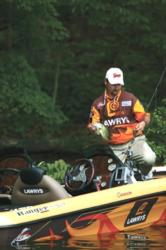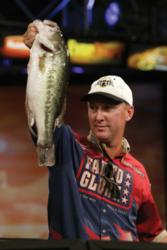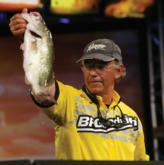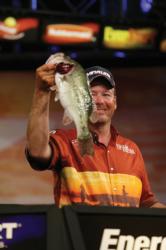Kennedy’s craft
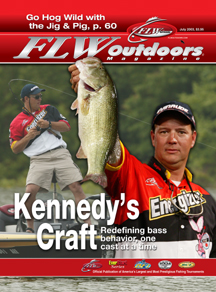
Steve Kennedy is redefining bass behavior, one cast at time
Steve Kennedy’s boat is a bit different from most boats on the Wal-Mart FLW Tour. Of course, it’s a Ranger, but it’s a 1988 354V Ranger. After 15 years of hard-core fishing, the boat’s clear coat is a little faded, and the carpet is worn.
Also, his boat is not as big or as fast as the other pros’ more contemporary models. Truth is, Kennedy’s little old Ranger looks out of place next to all the big, sparkly, fast boats found at each FLW Tour event.
Kennedy’s tow vehicle is a bit different, too. He does not have a big Suburban or a Silverado Extended Cab truck. Nope. He pulls his boat around the country from his hometown of Auburn, Ala., with a small Chevy S-10 pickup.
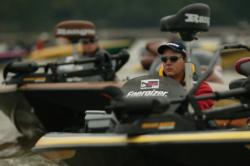 Come to think of it, Kennedy’s rods and reels are a little ragged as well. The shiny enamel has worn off most of his rods, and the frazzled cork handles have been taped back together. His reels date back to a time when “anti-backlash” mechanisms were cutting-edge fishing technology.
Come to think of it, Kennedy’s rods and reels are a little ragged as well. The shiny enamel has worn off most of his rods, and the frazzled cork handles have been taped back together. His reels date back to a time when “anti-backlash” mechanisms were cutting-edge fishing technology.
Kennedy’s accommodations at tournaments are bare-bones, too. Most of the time he stays at a campground not in a big fancy camper but in a tent with his wife Julia and their dog Louie.
Indeed, Kennedy’s bass-fishing craft is unconventional in more ways than one. He does not subscribe to the popular bassing philosophy that better equipment makes better fishermen.
“To me, competitive fishing is about fishing talent, not who has the newest or fastest boat – that’s for boat races,” he said. “That’s one reason I was drawn to this sport – it’s not about having the best equipment, it’s about being the best fisherman. What I lack in equipment I can compensate for with desire and skill.”
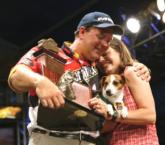 As for living in campgrounds, Kennedy says that’s a lifestyle that he and Julia are perfectly comfortable with.
As for living in campgrounds, Kennedy says that’s a lifestyle that he and Julia are perfectly comfortable with.
“We sleep in a tent because we like to camp; we love the outdoors,” he said. “For us it’s part of our fishing lifestyle – camping and fishing. That’s how I was raised. Let’s put it this way, even if I were a millionaire and there was no such thing as bass tournaments, we would still be camped next to a lake in a tent and fishing out of an old boat. It’s what we love to do.”
Kennedy’s bohemian approach to the top level of professional bass fishing extends under the water as well. Just as he finds fault in the theory that faster boats make better bass anglers, he is constantly testing popular beliefs about bass behavior, one cast at a time.
So when the water started rising at the Kentucky Lake FLW Tour event in May, the flippers flocked to the bushes, and the local ledge experts headed out deep. But somewhere between the bank and the ledges, Kennedy was sitting over a gold mine of fish in his unconventional craft.
Lake conditions
Abnormally high water on Kentucky and Barkley lakes was the talk of the town when the FLW Tour set up shop on its own doorstep in Benton, Ky., May 14-17. While a few feet of water rising into the bushes is common and even welcomed by many anglers, having bushes completely submerged under 6 feet of water is abnormal.
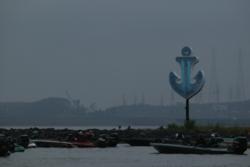 An overabundance of rain in the Tennessee Valley the week before had TVA impoundments brimming over, and the excess water was being ushered to Kentucky Lake as quickly as possible. In a 10-day period beginning six days before the tournament and extending through the four-day event, the lakes rose nearly 8 feet.
An overabundance of rain in the Tennessee Valley the week before had TVA impoundments brimming over, and the excess water was being ushered to Kentucky Lake as quickly as possible. In a 10-day period beginning six days before the tournament and extending through the four-day event, the lakes rose nearly 8 feet.
The water flooded the banks of Kentucky and Barkley lakes, inundating parking lots, golf courses, yards and hundreds of miles of forest with water. While the water was rising nearly a foot per day, the weather became unusually stable – especially in terms of wind, which can be vicious on the big lakes.
Daytime highs rose into the 70s, and nighttime lows reached the low-60s. Each day of the tournament was a fair mixture of sun and clouds except for the finals on Saturday, which brought all-day clouds and rain.
The water temperature ranged from 70 to 75 degrees on both lakes. Due to the rising water, the water clarity was a bit off-colored in each reservoir, but it was not muddy. As the tournament progressed, some of the water in the creeks actually cleared up as water was being pulled through the system.
Predominant patterns
If the fast-rising water on Kentucky Lake was abnormal, then the fishing patterns that developed because of it were even stranger.
Similar to bass on other fluctuating impoundments, Kentucky Lake bass are known for moving shallow with rising water, especially in the spring. So when the water started rising rapidly several days before practice, the FLW Tour’s notable flippers had smiles plastered on their faces as they brandished 7.5-foot rods and 30-pound-test line.
But during the qualifying rounds, it became apparent that a tournament being dominated by flippers was not coming to fruition. Yet the local ledge dredgers like FLW Tour points leader Dan Morehead and hometown favorite Terry Bolton, both of Paducah, Ky., were not the ones weighing in the big bags, either.
Instead, the fish were doing some strange things on Kentucky Lake. Tom Monsoor led day one by dragging a jig and a Carolina rig. After day two, Kevin VanDam defended the shallow-water flipping bite by leading the tournament with 10 bass weighing 37 pounds, 10 ounces. VanDam’s pattern eventually faltered, however, leaving him in 10th place with eight bass weighing 15 pounds, 8 ounces.
“I knew coming into this that the shallow-water flipping bite was going away,” he said. “I was fishing short, main-lake pockets in Kentucky Lake – some of the last places these fish spawn – but they were leaving fast.”
On day three, Kennedy and Davy Hite got into an offshore Carolina-rigging and crankbait war. As the leaders revealed more about their patterns, some light was shed on the mystery of what the Kentucky Lake bass were doing.
Essentially, the bass were offshore but near shore – that is, the fish were relating to offshore structure as they typically do in postspawn, but since the water was so high, they did not have to move way out on the main lake to find their comfortable 10- to 12-foot-deep ledges.
Kennedy even believes that some of the fish that had already moved out to main-lake ledges moved back into the bays and related to offshore contours there.
The bass started relating to the first contours they could find in 8 to 12 feet of water, which were small creek channels and points in the back of bays. It was a pattern that shattered the notion that bass always move shallow with the water in the springtime.
“In 27 years of bass fishing, I have never seen so many fish leave the bank with rising water, especially in the springtime,” said FLW Tour pro Larry Nixon. “It goes against everything I have learned about bass in rising water. That just shows that no matter how much we think we know about bass, we will never know everything about these crazy fish.”
In the end, the top four anglers had all discovered fish that were offshore but near shore on the first contour breaks in 8 to 12 feet of water.
The only shallow-water angler to end up in the top five was Jeffrey Thomas of Broadway, N.C.
After a day-one showing of four fish weighing 10 pounds, 13 ounces, Thomas was just an afterthought in 67th place. But on day two, he rocketed back with a 17-pound, 12-ounce limit to claim the final spot in the top-10 cut.
On day one, Thomas tried to make a spinner-bait bite work over on Barkley but just could not fill out his limit. On day two, he returned to Barkley but switched to a buzzbait.
“We had a lot more clouds the second day, and I think that helped the top-water bite,” he said. “After I got my limit on the buzzbait, I got on a strong pattern of flipping cypress trees. I had almost 18 pounds, and my co-angler had a big bag, too.”
On day three, Thomas’ cypress tree pattern fizzled. With the sun shining, his buzzbait bite dried up, too. “I don’t know what happened to that cypress tree deal,” he said. “All I knew to do was go back to my Hawg Caller spinner bait (3/4-ounce, white and chartreuse with two No. 4 1/2 willow-leaf blades). I caught four bass on it, just like I did on the first day.”
With Barkley Lake fading on him, Thomas decided to stay close in Kentucky Lake on day four and throw a buzzbait all day. “The weather kind of favored the buzzbait with the clouds and wind,” he said.
Thomas fished the buzzbait anywhere he could get to the bank. “I fished cow pastures, people’s front yards and fields,” he said. “I just covered as much of that kind of water as I could find.”
The effort netted Thomas a solid final-day limit of 14 pounds, 10 ounces.
His buzzbait was a 1/4-ounce Lunker Lure (white and chartreuse) tied to 17-pound-test Stren Magnaflex line and fished on a Furnace Bay 6-foot-10-inch spinner-bait rod. His flipping on the second day was done with a 1/2-ounce Lunker Lure Rattleback (brown) with a green pumpkin swim-tail trailer. He flipped with 25-pound-test Stren Magnaflex and a Furnace Bay flipping stick.
Mike Surman of Boca Raton, Fla., qualified for the finals in ninth place. He maintained his ninth-place standing on day three but made a substantial comeback on day four, weighing in a 19-pound, 8-ounce limit to drive himself into a fourth-place finish.
Like the three anglers who finished above him, Surman was on the offshore-but-near-shore Carolina-rigging pattern from the beginning of competition.
“I found fish off the bank in practice, lots of them, but I could not catch any big ones,” he said. “But something changed, because on the first day of the tournament I went to get a quick limit of keepers on my offshore spot and caught 15 pounds in eight casts. I could not believe it.”
During the first two days, Surman’s primary spot on Kentucky Lake was located about 40 miles south. He described the key feature as a roadbed that cut across two bays.
“The little ditches that ran out of these two bays dumped into a channel that ran alongside the roadbed,” he said. “It was a perfect spot. The roadbed was about 6 feet deep on top and dropped to 10 to 12 feet, where the little ditches dumped in. If the water had been normal level, this would have all been too shallow.”
During the first two days, Surman stuck with a Carolina rig that consisted of 15-pound-test main line and 12-pound-test leader, both Berkley Big Game line. He used a Gambler 3/4-ounce rattling Carolina-rig weight, and his plastic baits were either a Gambler Bacon Rind or a Gambler 6-inch lizard, both in green pumpkin.
By day three, Surman’s roadbed spot was giving out of fish, as indicated by his 9-pound, 15-ounce limit.
On day four, he looked for alternatives. “The roadbed was a long ride, and we had a short day, so I decided to try a few places close before making the long run,” Surman said. “On my third stop, I caught 12 pounds pretty quickly, and I decided just to stay on the north end instead of running all the way to my spot that I had already beat on for three days.”
In addition to running new water, Surman also employed a new crankbait – a Rapala DT-10 in a shad pattern. “The bites on the crankbait were not as plentiful as the bites I could get on the rig, but they were much better quality,” he said.
Surman threw the DT-10 on 12-pound-test Berkley Trilene. “The places I was fishing on the north end were similar to the places I was fishing on the south end – channel breaks in main-lake bays,” he said.
After Tom Monsoor of La Crosse, Wis., led day one with a 20-pound, 3-ounce limit, he brought in limits in the middle teens the rest of the week to finish third.
Monsoor described all the places he was fishing near the Highway 68 bridge as “drain-outs” or “run-outs” in the back of bays.
“Drain-outs are those little ditches that come running out of the woods,” he said. “Bass school up on those kinds of places in the postspawn to feed. Those drain-outs are like big funnels that funnel all of the bait right to the bass.”
During the first two days, Monsoor alternated between a Carolina rig and his own homemade jig in “drain-outs” in 8 to 12 feet of water.
His Carolina rig featured a Berkley Power Hawg and a 1-ounce weight. “I think the heavier weight caused more commotion on the bottom – clacking on the rocks and stirring up mud – and that seemed to improve the bite considerably,” he said.
His jig was 3/8-ounce in size and was rigged with a blue and brown grub. He fished the jig on 12- and 15-pound-test green Berkley Big Game line.
Monsoor saved four of his best spots specifically for the finals. “Locals watched me catch my fish during the first couple of days and they couldn’t resist it, they fished my spots after I left,” he said. “So I saved a few for Saturday.”
Monsoor had another trick up his sleeve for the final day. He switched to a crankbait – a Norman Deep Little “N” in chartreuse with a blue back. “It’s the local hot color here,” he said. “Unfortunately, I only had one bait in that color.”
All was going according to plan for Monsoor on the final day until he lost the crankbait. “I had caught a limit on the Carolina rig and was catching them every cast,” he said. “Then I picked up that crankbait and caught a big one. Then I caught another big one and culled again. I caught 10 keepers in a row and then hung it up and broke it off. After that I could not catch another keeper on any other color or kind of crankbait.”
Hite a well-versed pro from Prosperity, S.C., tried and tried to get on flipping fish in Barkley Lake’s flooded bushes during practice, but he could never get a solid bite going.
On the final day of practice, Hite decided to sample waters 80 to 90 miles south of the launch site. “I found some creek channels and points where a Carolina rig or crankbait would never hit the bottom without a fish eating it,” he said.
Hite made the long run all four days to his prolific creek ditches. Like others in the top 10, Hite fished a Carolina rig for the bulk of his fishing. He was using a Gambler lizard and a Ring-Fry in green pumpkin on his 3/4-ounce Carolina rig. His big-fish producer was a 1/2-ounce Lunker Lure Rattleback jig in pumpkin and chartreuse.
“On a couple of my spots, I was actually fishing submerged bushes on the end of points,” he said. “After the Carolina rig bite slowed, I would throw the jig on those outside point bushes (10 feet) and kind of snap my rod tip to get a reaction bite. I caught a lot of fish on the rig, but without a doubt, all of my quality fish came on the jig.”
One thing that surprised Hite was the number of fish he had to go through on one spot to catch big fish. “Usually with these offshore deals, the bigger fish bite first and then the little ones bite,” he said. “But here it was just the opposite. I had to catch 50 or 60 small ones, and then the big ones would bite.”
Steve Kennedy: Champion
En route to winning the Kentucky Lake event with a whopping two-day total of 10 bass weighing 44 pounds, 14 ounces, Kennedy had two things in his favor: a lot of practice time and co-angler Ralph Wilson of Warner Robins, Ga., in his boat during that practice.
Ten days of practice allowed Kennedy to see how the lake changed during the entire course of the rising water, and having Wilson in the boat proved that the fish were biting a Carolina rig.
“Ralph loves that Carolina rig,” Kennedy said. “He threw it with me in practice and proved to me that the fish wanted that rig more than anything else.”
In fact, Wilson was responsible for helping find Kennedy’s primary honeyhole.
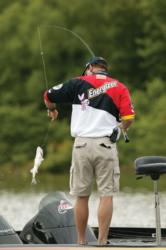 Before the water rose, Kennedy had been catching fish both in the bushes and out deep. What Kennedy noticed was that as the water started rising, both patterns went away.
Before the water rose, Kennedy had been catching fish both in the bushes and out deep. What Kennedy noticed was that as the water started rising, both patterns went away.
He had located deep-cranking fish on structure in 11 feet of water earlier in the week, but as the water got higher, he could not get bites on those places.
The number of keepers he was catching out of the bushes began to dwindle dramatically, too. “I could catch a bunch out of the bushes, but the number of quality fish just disappeared,” he said.
With both patterns shrinking, Kennedy was scratching his head as to what happened to the quality fish. Fortunately, Ralph Wilson was providing all the answers.
“On Monday morning, I started running pockets on the LBL side of Kentucky Lake near the (Highway) 68 bridge,” Kennedy said. “I would pull up to flip the bushes, and Ralph would start catching them on the rig out on the other side of the boat. On one spot he caught a couple of 3-pounders and a 5-pounder in as many casts. Before I could even dig my Carolina rig out, he had 20 pounds. That’s the spot I won the tournament on.”
Once Kennedy discovered how the fish were relating to the primary contours in the bays, he knew what to look for. He found several other spots holding fish, but nothing produced like the honeyhole that he and Wilson found.
Kennedy had no idea how many fish were on the spot until he got into a catching contest with a local boat on the first day of the tournament.
“I pulled in there and started catching fish every cast. Then a boat came out of the ditch back in the woods – they had seen us catching them,” he said. “Well, they decided to catch some, too. I already had my limit and was ready to leave, but I wanted to make sure that I did not leave the local boat any big ones, so I stayed in there and kept catching fish. For two hours my partner and I caught fish on nearly every cast. It was unreal. I did not think it was possible for that many fish to be on a single spot.
“It’s not often that having a local boat on your spot is a good thing, but in this case it was, because they really forced me to pressure that hole, and the more I caught, the bigger they got.”
Kennedy essentially hammered that same hole for four days, and it kept getting better as the tournament wore on, giving him his two 20-pound-plus bags in the finals.
The spot was a bare, hard spot made of gravel on what would have been the old shoreline located between the bushes and a line of milfoil that grew out in the middle of the bay. It was about 50 yards long and 30 yards wide and featured a gentle slope from 7 feet (where the bushes started) down to about 15 feet (where the grass started).
Kennedy used a variety of baits throughout the week, but his best two were a Carolina rig and a crankbait. His Carolina rig consisted of a 3/4-ounce weight and one of three plastics: a Baby Brush Hog, a Trick Worm or a Senko, all in green pumpkin.
His two best crankbaits were a Fat Free Shad and a Rapala DT-10, both hand-painted in custom colors. He cranked the crankbait on 10-pound-test P-line Floroclear.
“I really believe those fish were moving in there every day off the main lake,” he said. “I think the rising water and heavy current pushed them off their deeper ledges into shallower places in bays that were protected from the current. But the fish still wanted to relate to some kind of bottom contour.”
According to Kentucky Lake experts, these were unconventional places for bass to be located given the lake conditions. But then again, Kennedy is an unconventional kind of angler.
When asked if he was going to use some of his $100,000 to buy a new boat, he said, “Why do I need a new one? The one I have now seems to work pretty good.”
Fish Bites
8 – The number of feet Kentucky Lake rose from the start of practice to the end of the tournament.
10 – Number of pounds that Steve Kennedy had as a margin of victory after days three and four.
15 – The age, in years, of Kennedy’s Ranger boat that he uses in Wal-Mart FLW Tour events.
150 – A “conservative estimate” of the number of fish Kellogg’s pro Clark Wendlandt caught on day two of the tournament.
7-2 – The size, in pounds and ounces, of the tournament’s biggest bass, caught by pro Robert Beatty of Clermont, Fla.
1 – number of chartreuse and blue Deep Little “N” crankbaits that Tom Monsoor had when he lost it during a bass feeding frenzy on day four.
10 – The number of keeper bass Monsoor had caught on the crankbait just before he lost it.
0 – Number of keepers Monsoor caught on other crankbaits after he lost the chartreuse and blue crankbait.
160 – Number of miles Davy Hite estimates he was running per day to fish his prolific holes.
Related articles:
